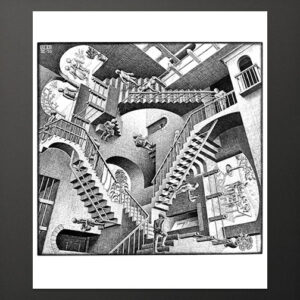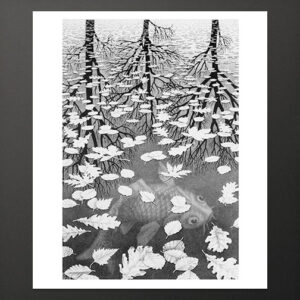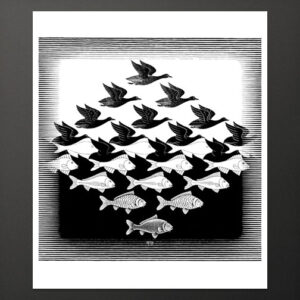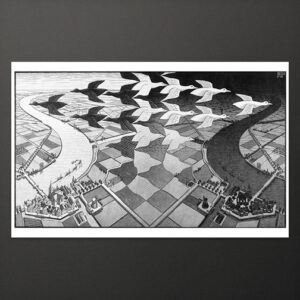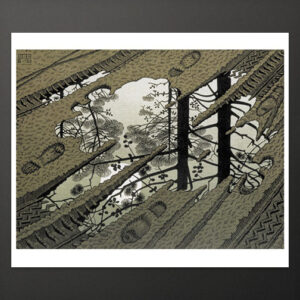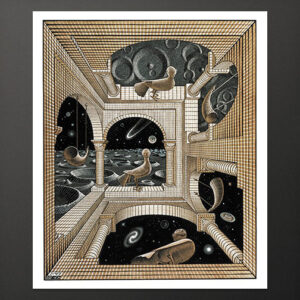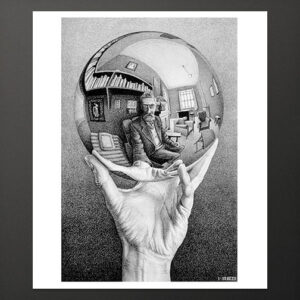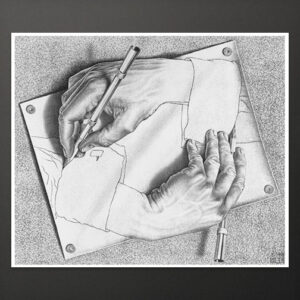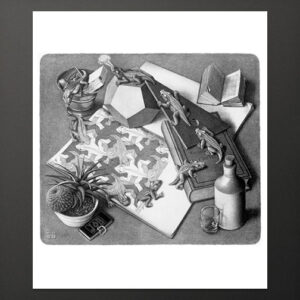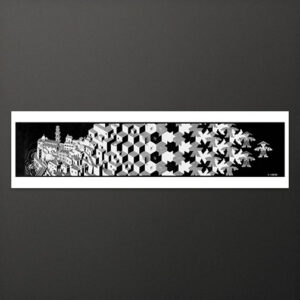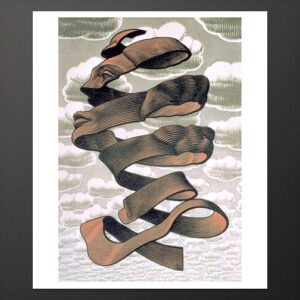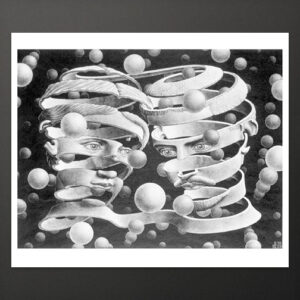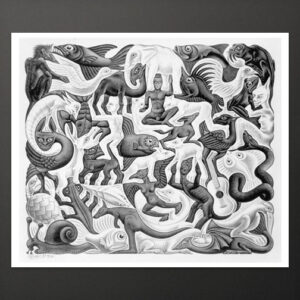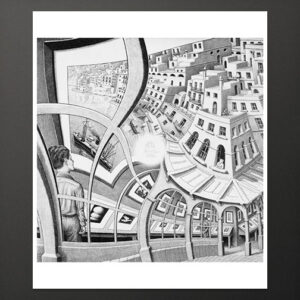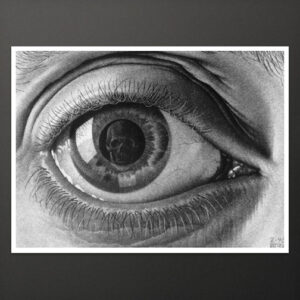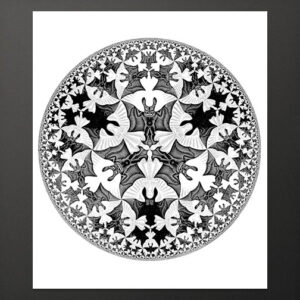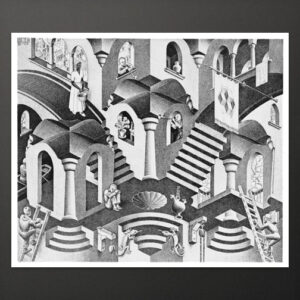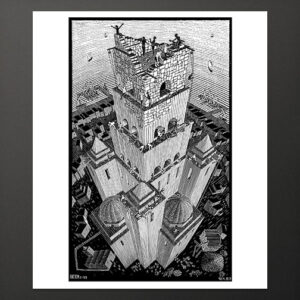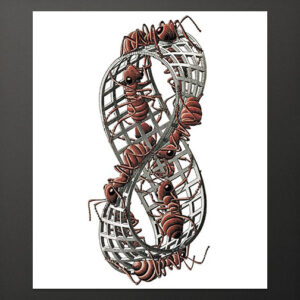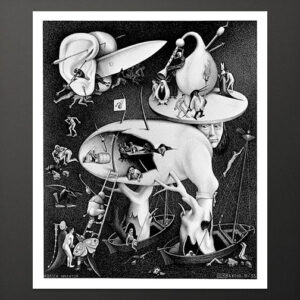-
Relativity, lithograph, 1953. "Three gravitational forces act perpendicular to each other here. Three Earth surfaces intersect each other at right angles and on each of them people live. Two inhabitants of different worlds cannot walk, sit or stand on the same floor, because their notions of what is horizontal and what is vertical are not the same. But they can use the same staircase together. On the top staircase shown here, two people move next to each other in the same direction. Yet one descends and the other climbs up. Contact between them is impossible, because they live in different worlds and therefore cannot know of each other's existence." ~ M.C. Escher, Grafiek en Tekeningen. Printed in black and white on poster paper. Paper size : 55 x 65 cm. Image size approx : 43 x 40,5 cm. Packaged in cardboard tube.
-
Waterfall, lithograph, 1961. "In the same British Journal of Psychology article that inspired Ascending and Descending, R. Penrose published the perspective drawing of a triangle. A copy of which is reproduced here. It is composed of square beams placed at right angles to each other. If we follow all the parts of this construction one by one, no error can be discovered. Yet it is an impossible construct, because there are sudden changes in the interpretation of the distance between our eye and our object. The impossible triangle is applied three times. Falling water sets a mill wheel in motion and then flows slowly in a zigzag manner down a sloping chute between two towers to the point where the waterfall begins again. The miller has to add a bucket of water every now and then to eliminate losses due to evaporation. The two towers are the same height and yet the right one is one floor lower than the left." ~ M.C. Escher, Grafiek en Tekeningen. Printed in black and white on poster paper. Paper size : 55 x 65 cm. Image size approx : 40 x 50 cm. Packaged in cardboard tube.
-
Three worlds, lithograph, 1955. "The representation of this forest pond consists of three elements: the autumn leaves that indicate the plane of the water surface, the mirror images of three trees in the background, and the fish in the foreground in the transparent water." ~ M.C. Escher, Grafiek en Tekeningen. Printed in black and white on poster paper. Paper size : 55 x 65 cm. Image size approx : 40 x 58 cm. Packaged in cardboard tube.
-
Sky and Water I, woodcut, 1938. "In the horizontal center strip, birds and fish are equal. But we associate flying with the air, so for the black bird the four white fish surrounding it are the air in which it flies. In the same way, swimming reminds us of water, so the four black birds surrounding the fish become for him the water in which he swims." ~ M.C. Escher, Grafiek en Tekeningen. Printed in black and white on poster paper. Paper size : 55 x 65 cm. Image size : 50 x 50 cm. Packaged in cardboard tube.
-
Day and Night, woodcut of 2 blocks, 1938. "Gray rectangular fields develop upwards into silhouettes of white and black birds; the black ones fly to the left, the white ones to the right as two oppositely directed formations. On the left, the white ones flow into each other and unite into a daytime sky and landscape. On the right, the black ones merge into night. The day and night landscapes are each other's mirror images, which unite by means of gray fields, from which the birds develop again." ~ M.C. Escher, Grafiek en Tekeningen. Printed in black and white on poster paper. Paper size: 86,7 x 55 cm. Image size approx 78,5 x 45,5 cm. Packaged in cardboard tube.
-
Mud puddle, woodcut of 3 blocks, 1952. "The cloudless evening sky is reflected in a mud puddle left in the hollow of a forest road after a rain shower. Traces of two trucks, two bicycles and two pedestrians are imprinted in the marshy ground." ~ M.C. Escher, Grafiek en Tekeningen. Printed in color on 170gram paper. Paper size : 55 x 65 cm. Image size approx : 49 x 36,2 cm. Packaged in cardboard tube.
-
Other World, wood engraving of three blocks, 1947. "The interior of a cube-shaped extension. Openings in the five visible walls offer a view of three different scenes. Through the upper pair one can see the ground, almost vertically downwards; the middle two are at eye level and show the horizon; through the lower pair, one looks steeply up at the stars. Each surface of this structure, which logically unites nadir, horizon and zenith, has a triple function. The rear surface in the center, for example, is a wall in relation to the horizon, a floor in relation to it the upper view and a ceiling with regard to the view of the starry sky." ~ M.C. Escher, Grafiek en Tekeningen. Printed in color on poster paper. Paper size: 55 x 65 cm. Image size approx : 41,5 x 50,5 cm. Packaged in cardboard tube.
-
Ascending and Descending, lithograph, 1960. "The endless staircase, that is the main motif of this imagery, was taken from an article by L.S. Penrose in the February 1958 issue of the British Journal of Psychology. A rectangular courtyard is bordered by a building that has an endless staircase as a roof covering. The inhabitants of this housing complex may well be monks, members of an unknown sect. It may be their ritual duty to climb this staircase for a few hours every day. When they are tired, they are apparently allowed to turn around and descend instead of climbing. But both directions, although meaningful, are equally restless. Two recalcitrant individuals refuse for the time being to participate in this exercise. They think what they want about it, but perhaps sooner or later they will see their error." ~ M.C. Escher, Grafiek en Tekeningen. Printed in black and white on poster paper. Paper size : 55 x 65 cm. Image size approx : 44,5 x 54 cm. Packaged in cardboard tube.
-
Hand with Reflecting Sphere, lithograph, 1935. "A reflective sphere rests on the hand of the draftsman. He sees a much more complete picture of his surroundings in that mirror than through direct observation, because he sees almost the entire space around him: four walls, floor and ceiling of his room are , albeit distorted, compressed into that disk. His head, more precisely: the point right between his eyes, is in the center. No matter how he turns, he remains the center ." ~ M.C. Escher, Grafiek en Tekeningen. Printed in black and white on 170 gram paper. Paper size : 55 x 65 cm. Image size approx : 35,2 x 52,7 cm. Packaged in cardboard tube.
-
Drawing Hands, lithograph, 1948. "A piece of paper is pinned to a surface with four drawing pins. A right hand is busy sketching the sleeve of a shirt on that drawing paper. The hand has not yet finished its work at that spot, but somewhat further to the right it has a left hand protruding from the sleeve, already depicted in such detail that it rises from the plane and in turn, like a living body part, outlines the sleeve from which the right hand emerges." M.C. Escher, Grafiek en Tekeningen. Printed in black and white on 170 gram paper. Paper size : 65 x 55 cm. Image size approx : 54,5 x 46 cm. Packaged in cardboard tube.
-
Belvedere, lithograph, 1958 "In the foreground, bottom left, is a sheet of paper on which the edges of a cube have been drawn. Two circles indicate the places where edges cross each other. Which edge is in front, which is behind? Front and back at the same time is in a three -dimensional world is not possible and therefore cannot be depicted. But an object can be drawn that represents a different reality from above than from below. The boy sitting on the bench has such a cube-like absurdity in his hands. He looks thoughtfully at the impossible object and is apparently unaware that the belvedere behind him has been built in the same impossible way. On the floor of the lower platform, i.e. indoors, there is a ladder, along which two people are busy climbing. But when they arrive one floor higher, they are back in the open air and have to enter the building again. Is it any wonder that no one in the group cares about the fate of the prisoner in the basement, who puts his head through the bars, whimpering?" ~ M.C. Escher, Grafiek en Tekeningen. Printed in black and white on 170 gram paper. Paper size : 55 x 65 cm. Image size approx : 35 x 55 cm. Shipped in cardboard tube.
-
M.C. Escher’s Reptiles (1943) is a whimsical yet thought-provoking lithograph that blurs the line between two-dimensional and three-dimensional space. In this print, a series of small, tessellated reptilian figures emerge from the flat surface of a drawing, come to life, and crawl across a cluttered tabletop, only to return to their original, flat form. This cyclical movement creates a fascinating interplay between art and reality, showcasing Escher’s signature themes of transformation, illusion, and the paradoxical relationship between the flat and the spatial. With its meticulous detail and playful narrative, Reptiles invites viewers to question perception and the nature of artistic creation itself. Printed in black and white on poster paper. Packaged in cardboard tube. Paper size : 55 x 65 cm. Image size approx : 43,5 x 38 cm.
-
House of Stairs, lithograph, 1951. "A game element occurs that was already discussed in the regular division of the surface, the glide reflection. Almost the entire top half of the print is a mirror image of the bottom half. The top step, along which a creature descends from left to right, is even mirrored twice: in the middle and then again at the bottom. On the stairs in the upper right corner, the contrast between 'climbing' and 'descending' has been removed: two rows of animals go next to each other, but one rises and the other descends." ~ M.C. Escher, Grafiek en Tekeningen. Printed in black and white on 170grams paper. Packaged in cardboard tube. Paper size : 45 x 79,5 cm. Image size approx : 36,7 x 72,3 cm.
-
Rind, wood engraving of 4 blocks printed, 1955. "Like the spiral skin of a fruit, like a hollow, fragmentary sculpture, a female effigy floats through space. The depth effect is enhanced by a cloud cover receding towards the horizon." ~ M.C. Escher, Grafiek en Tekeningen. Printed in color on 170 gram paper. Paper size : 55 x 65 cm. Image size approx : 37,7 x 55 cm. Packaged in cardboard tube.
-
Bond of Union, lithograph, 1956. "Two spirals flow into each other and depict a woman's head on the left and a man's on the right. Like an endless ribbon, their foreheads intertwined, they form a unity. The spatial effect is enhanced by floating spheres, in front of, in and behind the hollow effigies." ~ M.C. Escher, Grafiek en Tekeningen. Printed in black and white on 170 gram paper. Paper size 65 x 55 cm. Image size approx : 58 x 43,7 cm. Shipped in cardboard tube.
-
Plane Filling II, lithograph, 1957. "... They could also only be created after years of training with regular fillings. The recognizability of their components as natural objects plays an even more important role. Enjoyment in the difficult game, without symbolic ulterior motives, was the only real reason for their creation... The rectangularity of the entire surface is the only regularity that is still present here. Of the inner figures, only a few are bordered by four surrounding ones. The immediate environment of the frog consists of two figures; the guitar is bounded by three, the rooster by five, and the ostrich (if it is one) by six. The total number is only apparent after careful counting. " ~ M.C. Escher, Grafiek en Tekeningen. Printed in black and white on poster paper. Paper size : 55 x 65 cm. Image size approx : 55,5 x 47,5 cm. Packaged in cardboard tube.
-
Print Gallery, lithograph, 1956. "[In this print an] enlargement towards the center, a ring-shaped expansion takes place, around the empty center, in the direction of a clock. At the bottom right we enter through a gate an exhibition gallery with prints on tables and on walls. First we pass a visitor with his hands behind his back and then, in the lower left corner, a young man who is already four times as big. His head has already expanded in proportion to his hand. He looks at the last print of a series on the wall and follows the details one by one: the boat, the water and the houses in the background. From there, his gaze continues to slide from left to right along increasingly larger blocks of houses down on the sloping roof that covers the exhibition gallery; that is where our tour began. The boy sees all these things as two-dimensional details of the print he is studying. Looking a little deeper, he sees himself, as part of the picture. " ~ M.C. Escher, Grafiek en Tekeningen. Printed in black and white on poster paper. Paper size : 55 x 65 cm. Image size approx : 47,2 x 46,3 cm. Packaged in cardboard tube.
-
Printed in black and white on 170gram paper. Packaged in cardboard tube. Paper size : 55 x 65 cm. Image size approx : 48,4 x 46,7 cm.
-
Eye, mezzotint, 1946. "The artist has depicted his own eye here, greatly enlarged in a concave shaving mirror. The pupil reflects him who is looking at all of us." ~ M.C. Escher, Grafiek en Tekeningen. Printed in black and white on 170gram paper. Paper size : 55 x 40 cm. Image size approx : 43 x 32 cm. Packaged in cardboard tube.
-
Circle Limit IV (Heaven and Hell or Angels and Devils), woodcut of 2 blocks printed, 1960. "Here too, the components shrink from the inside out. The six largest, three white angels and three black devils, are arranged radially around the center. The disc is divided into six sectors, in which the angels on a black background and the devils on a white background alternately dominate. Heaven and hell alternate six times." ~ M.C. Escher, Grafiek en Tekeningen. Printed in black and white on 170gram paper. Paper size : 55 x 65 cm. Image size approx: 49,2 x 49,2 cm. Packaged in cardboard tube.
-
Convex and Concave, lithograph, 1955. "Next to each other are three houses with a cross vault as a roof. The left one is seen externally, the right one internally and the middle one optionally from inside or outside. There are several such inversions on this picture shown; one of them is described here. There are two boys playing the flute. One on the left looks down on the roof of the middle house; if he climbs through his window he can jump onto the roof below. If he then jumps down again, he ends up one floor lower on the dark floor in front of the house. However, the right flute player sees that same cross vault above his head as a roof before him there is no floor, but a fathomless abyss." ~ M.C. Escher, Graphics and Drawings. Printed in black and white on 170 grams poster paper. Paper size : 55 x 65 cm. Image size : 56 x 47 cm. Packaged in cardboard tube.
-
Tower of Babel, woodcut, 1928. "It was assumed that the different races also emerged during the confusion of tongues; hence some construction workers are white, others black. The work has come to a standstill because they no longer understand each other. Since the quintessence of the drama takes place at the top of the tower under construction, it was shown, as if in a bird's eye view, from above. This resulted in the need for a strong perspective shift downwards." ~ M.C. Escher, Grafiek en Tekeningen. Printed in black and white on 170 gram paper. Paper size : 55 x 65 cm. Image size approx : 32,3 x 52 cm. Packaged in cardboard tube.
-
Liberation, lithograph, 1955. "On the uniform-gray surface of an unfurling strip of paper, a development takes place, from bottom to top, simultaneously in shape and contrast. Triangles, barely visible at first, turn into more complicated figures as their mutual color contrast increases. In the center they are completed as white and black birds. From here onwards they free themselves from each other and fly into the world as independent beings. That is why the paper strip on which they were drawn disappears." ~ M.C. Escher, Grafiek en Tekeningen. Printed in black and white on 170 gram paper. Paper size : 75 x 34 cm. Image size approx : 30 x 66 cm. Packaged in cardboard tube.
-
Möbius II, woodcut from 3 blocks, 1963. "A closed, looped ribbon usually has two separate surfaces, one inside and one outside. On this strip, however, nine red ants follow each other and walk both the front and the reverse side. So the ribbon has only one surface." ~ M.C. Escher, Grafiek en Tekeningen. Printed in color on poster paper. Paper size: 55 x 65 cm. Image size approx : 27 x 58 cm. Packaged in cardboard tube.
-
Printed in black and white on 170gram paper. Packaged in cardboard tube. Paper size : 55 x 65 cm. Image size approx : 44 x 51,7.

